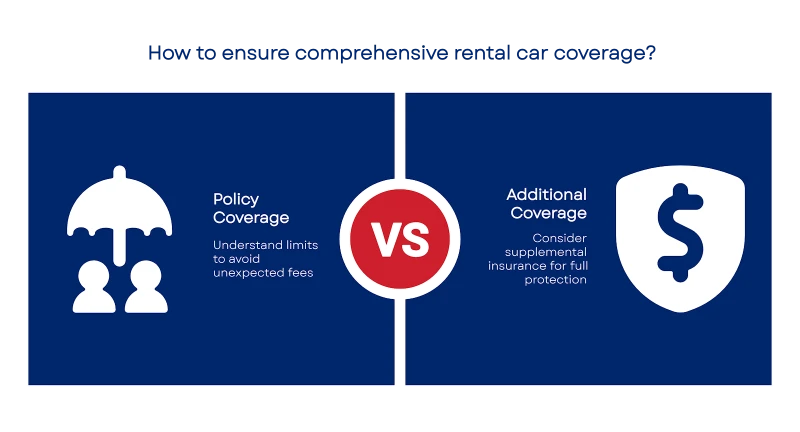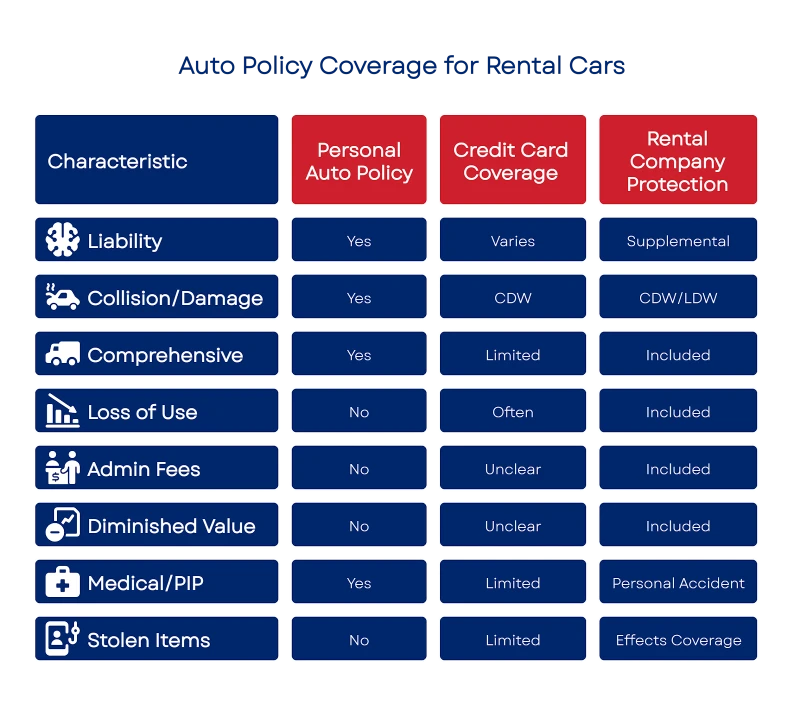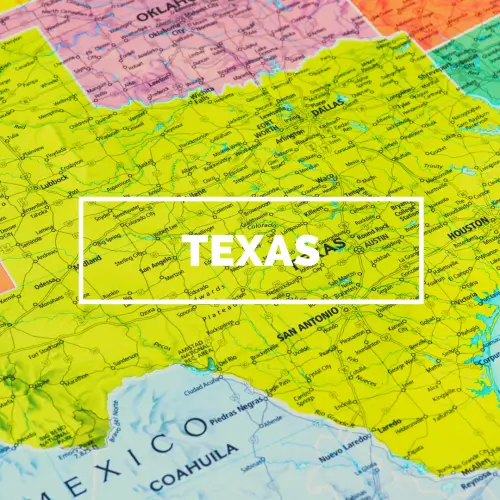In many situations, it does, but some costs are not included.
Many drivers believe their policy covers any incident that occurs while they are driving a rental car. That is not always true. If you don’t understand the limits of your coverage before renting, you could end up responsible for fees your policy doesn’t cover.
What You’ll Learn
This article explains:
Which parts of your car insurance usually apply to a rental car, and which parts do not
Three standard charges that your car insurance likely does not pay for
How to choose between your insurance, a credit card benefit, or the rental company’s insurance when you pick up the car
Summary
Most U.S. personal auto policies automatically transfer the same liability, collision, and comprehensive protections to a rental car used for personal travel inside the United States and Canada. Yet, three common gaps, such as loss-of-use fees, administrative charges, and diminished value, are not covered.
What Typically Carries Over
The rental must be a private passenger vehicle used for personal (not business) purposes and kept within U.S./Canadian borders.
Common “Hidden” Costs Your Policy Won’t Pay
Your Three Options at the Counter
Rely on personal auto policy. Accept your deductible and any uncovered fees.
Use a credit card’s collision damage waiver. Premium travel cards (e.g., Chase Sapphire Reserve, Capital One Venture X) offer primary CDW coverage up to approximately $75,000 and often reimburse loss-of-use expenses. Other cards provide secondary coverage that only pays your deductible. You must pay with the card and decline the agency’s CDW.
Buy the rental company’s protection.
Simple Decision Tips
Pre-Trip Checklist
Contact your agent to verify deductibles and any exclusions for rentals or business use.
Read your credit card’s Guide to Benefits: check country, vehicle type, and length-of-rental limits.
Photograph the car (inside and out) at pick-up and drop-off.
List every driver on the contract; unlisted drivers void coverage.
Keep receipts and accident reports for at least 12 months.
American drivers with collision, comprehensive coverage, and a solid travel credit card can usually skip the rental desk upsell, provided they confirm their loss-of-use and deductible exposures. A five-minute call to your insurer or card issuer before you travel can prevent four-figure surprises.
What Your Car Insurance Does Cover on a Rental Car
Most personal car insurance policies extend some coverage to rental cars. It applies only if the rental is a private passenger vehicle used for personal driving and stays within the United States or Canada.
Here is what usually carries over from your policy:
Collision and comprehensive: Only if you already have these on your policy. You still pay your deductible if there is a claim.
Liability: Covers injury or property damage to others, up to the same limits you carry on your car.
Medical or personal injury protection (PIP): In states where it is available, this coverage pays for medical expenses for you and your passengers.
Uninsured or underinsured motorist: Works the same as in your car if another driver has little or no insurance.
Before relying on your policy, ensure the rental is not for business purposes and that the car type is not excluded.
The 3 Hidden Costs Your Policy Won’t Pay
Even with full coverage on your policy, there are fees that most insurance does not cover when you rent a car. These charges can add up quickly if you are not expecting them.
Administrative and towing fees: Extra charges for paperwork or moving the damaged vehicle. These typically range from $50 to $250 in total.
Diminished value: If the car loses resale value after an accident, the rental company may bill you for that loss. The cost can range from $500 to $3,000.
Loss of use: Rental companies often charge for the income they lose while the car is being repaired. It can range from $50 to $150 per day.
These costs are not part of your standard collision, comprehensive, or liability coverage. Even drivers with good policies are often surprised to see them on the final bill.
Your Options at the Rental Counter
When you rent a car, you need to decide how to handle insurance before you drive off the lot. Below are the three main options, explained clearly so you can make the best choice for your situation.
Use Your Auto Policy
If you already carry liability, collision, and comprehensive coverage on your vehicle, your policy typically extends to rental cars as well. It applies only if the rental is a private passenger car, used for personal purposes, and stays within the United States or Canada.
It is often the least expensive option, but it comes with a few drawbacks. You will still be responsible for your regular deductible if the car is damaged. Your policy also will not cover loss of use fees, administrative fees, or diminished value.
Before relying on your policy, call your insurance agent and ask:
Are there exclusions for rentals?
Will business use be covered?
Are there any special deductibles for rental cars?
Knowing these details before you rent will help avoid surprises.
Pay With a Premium Credit Card
Many premium credit cards include rental car insurance, often referred to as a collision damage waiver (CDW) or loss damage waiver (LDW). This benefit can help cover the costs of repair or replacement if the rental car is damaged or stolen.
Some cards offer primary coverage, which pays first and doesn’t require you to file a claim through your auto insurance. Others provide secondary coverage, which only pays what your policy doesn’t. Primary coverage is usually more beneficial because it can help protect you from potential rate increases on your insurance.
The waiver may also cover related fees, such as loss of use, which rental companies charge while the car is out of service for repairs, and towing costs if needed. However, coverage varies by card, so it’s essential to check your card’s benefits guide carefully.
To use this benefit, you need to:
Decline the rental company’s CDW/LDW coverage when picking up the car.
Pay for the entire rental with the credit card offering the benefit.
Before relying on this perk, confirm that the country you’re renting in, the type of vehicle, and the rental period are all covered under your card’s terms. Some cards exclude trucks, exotic cars, or rentals in certain countries.
If your credit card offers primary rental car coverage, it can be a cost-effective and convenient way to protect yourself without relying on your auto insurance policy.
Buy the Rental Company’s Insurance
Rental car companies offer their insurance products at the counter. These can give peace of mind, but they also add significant cost to your rental.
Here are the standard options they offer:
Collision damage waiver/loss damage waiver (CDW/LDW): Removes your responsibility for damage or theft of the rental car.
Personal accident and effects coverage: Pays for medical bills and stolen personal items.
Supplemental liability protection: Provides additional liability insurance, typically ranging from $300,000 to $1 million. These products make sense if you have only minimal insurance, no suitable credit card, or you want the rental company to handle all claims.
If you’re considering a high-value or classic car, you can explore enclosed auto transport service for situations where shipping your vehicle safely makes more sense than renting one at all.
How to Decide What’s Best for You
The right choice at the rental counter depends on the coverage you already have, the type of trip, and your comfort with risk. Below is a comprehensive breakdown of key considerations in everyday situations.
When to rely on your auto policy
You can use your policy if all of the following apply:
You carry liability, collision, and comprehensive coverage on your car.
The rental is a standard private passenger vehicle.
The rental is for personal use only, not for business purposes.
You will drive only within the United States or Canada.
Keep in mind:
You are still responsible for your deductible if a claim is made.
You will have to pay for fees that your policy doesn’t cover, such as loss of use or diminished value.
It is often the least expensive option if you already have full coverage and are willing to handle your claim if something happens.
When to use a premium credit card benefit
A premium credit card is a strong choice if you meet these conditions:
You decline the rental company’s CDW at the counter.
You pay for the entire rental with the card.
Your card offers primary collision damage waiver (CDW) coverage.
Your trip falls within the coverage limits of your card (please verify the vehicle type, location, and rental duration).
Why choose this:
It avoids filing a claim with your insurer.
It can cover specific fees, such as loss of use, that your policy does not.
You still rely on your policy for liability coverage unless you purchase supplemental liability.
Before relying on this, read your card’s benefits guide to confirm what is and is not omitted.
When to buy the rental company’s insurance
The rental company’s insurance is a good idea in these cases:
You don’t have a premium credit card with primary CDW.
You only carry the state minimum liability on your auto policy.
You want someone else to handle all claims and avoid using your insurance entirely.
You’re renting a luxury, exotic, or specialty vehicle that your own policy and credit card do not cover.
You’re renting outside the United States or Canada.
What the rental company offers:
Collision damage waiver/loss damage waiver (CDW/LDW): Removes your responsibility for damage or theft of the rental car.
Personal accident and effects: Covers injuries to you and passengers, and loss of personal belongings.
Supplemental liability protection: Adds higher liability coverage limits.
These options add cost, but can give peace of mind if you have gaps in your existing coverage.
Questions to ask yourself before deciding:
Am I comfortable paying my deductible and fees if I rely on my policy?
Am I renting for business or driving outside the U.S. or Canada?
Do I have collision and comprehensive coverage on my policy?
Does my credit card offer primary CDW, and does it cover the type of car and destination?
Does my personal policy cover rentals?
Checking your policy and credit card benefits a few minutes before your trip can save you from unexpected bills or unnecessary charges at the counter.
Pre-Trip Checklist: How to Prepare Before You Rent
Follow these steps before your rental to avoid surprise charges and denied claims.
Step 1: Check your auto insurance policy
Call your insurance agent or review your policy documents. Confirm that liability, collision, and comprehensive coverage apply to rental cars. Ask if there are exclusions for business use, luxury or specialty vehicles, or rentals outside the United States and Canada. Write down your deductible amounts, and verify if medical payments or uninsured motorist coverage extend to rentals.
Step 2: Review your credit card benefits
If you plan to pay with a credit card, check its benefits guide carefully. Many premium cards include a collision damage waiver, which may even cover some costs your auto policy does not.
Confirm whether coverage is primary or secondary, and note any exclusions such as certain countries, vehicle types, or rental periods. Ensure you understand what is required to file a claim, such as declining the rental company’s CDW and paying with that card.
Step 3: Identify coverage gaps
Understand what neither your auto insurance nor your credit card typically covers. Most do not pay for:
Administrative or towing charges
Diminished value after repairs
Loss of use fees
If you prefer to avoid these risks, consider a premium credit card that includes them or purchase additional protection from the rental company.
Step 4: Inspect the rental car
When you pick up the car, inspect it thoroughly. Take clear, time-stamped photos or videos of the exterior, interior, roof, wheels, and trunk. Have any existing damage noted on the rental company’s form before you leave. Do the same when you return the car, and save the photos in case of disputes.
Step 5: Make sure all drivers are listed
Verify that everyone who may drive the car is listed on the rental agreement. Driving without being listed can void both insurance and the rental company’s coverage. Ask about fees for additional drivers if needed.
Step 6: Keep all documents
Save copies of your rental agreement, payment receipts, inspection reports, and any damage or incident records. Keep these files for at least one year after your trip.
By following these steps, you can protect yourself, understand your coverage, and feel confident about your rental experience.
Understanding how insurance applies when a car is in someone else’s care is helpful beyond just rentals. This guide to auto transport insurance explains common gaps in coverage and what to look out for when another party handles your vehicle.
Final Thoughts
Renting a car may seem simple, but understanding how insurance works is just as important as choosing the right vehicle. When you know what your personal auto policy and credit card include, you can avoid paying for coverage you already have and plan for the costs they leave out.
Before your trip, review your insurance details, check your credit card benefits, and document the car carefully at pick-up and drop-off. These steps help you stay prepared and protect you from unexpected charges if something goes wrong during the rental.
If you’re not sure whether renting a car or shipping your own car makes more sense for your trip, it may help to review a first-time car shipping guide.
Need Help Shipping Your Car?
If you are moving or traveling and want your car waiting for you at your destination, AmeriFreight Car Shipping can help with vehicle shipping.
We work with trusted carriers to arrange reliable and affordable transport anywhere in the continental United States. We are ready to answer your questions, provide guidance, and keep you informed throughout the process.
Frequently Asked Questions (FAQs)
Are loaner cars usually free?
Not always. Some dealerships include a loaner for free, but others charge a daily fee. Always ask upfront.
Does insurance cover a rental car if your car is stolen?
Only if you have rental reimbursement coverage. Basic policies typically don’t pay for a rental after theft.
What happens if you total a rental car with insurance?
Your policy usually covers it if you have collision and comprehensive coverage, minus your deductible. A CDW or credit card benefit can also be applied.
Does roadside assistance cover rental cars?
Some plans, like AAA, cover rental cars. Many insurance roadside plans do not. Check your terms before you rent.
Disclaimer: This article is for general informational purposes only and does not constitute legal, insurance, or financial advice. Please review your insurance policy and consult with a licensed professional before making decisions about your coverage or rental agreements.






















